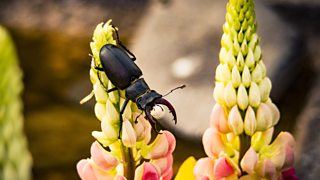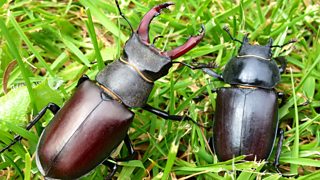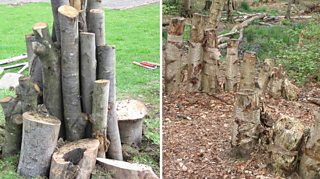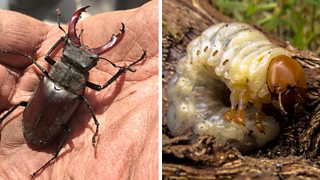How to attract stag beetles to your outdoor spaces
People's Trust for Endangered Species (PTES)
Partner organisation of the Watches
By Laura Bower, Conservation Officer at PTES
The stag beetle range stretches across Europe. The UK is at the north-west edge of its range and we seem to have a stronghold here, as you can see from

Male stag beetle on flower by Peter Jones
Although stag beetles have experienced historical population declines here in the UK and their numbers appear to be stabilising, they still need our help. Stag beetles are now even extinct in two countries in Europe, so it’s important that we protect these beautiful beetles and do all we can to make our gardens, parks and woodlands a haven for them.

Male and female stag beetles by Ross Bower
How can I attract stag beetles to my garden?
1. Retain stumps of dead and decaying wood – it’s habitat and food!
Stag beetle larvae need dead wood to feed on as they grow and develop throughout their long lives underground, so the most important thing you can do to attract stag beetles into your garden is to retain dead wood and tree stumps. When tidying up our parks and gardens, tree stumps are often removed. This is problematic for stag beetles because the wood acts as both their habitat and food source. But with careful planting, they can be made into a feature of your garden, for example you could grow climbing flowers up stumps.
2. Make a log pyramid
The perfect lockdown activity! The next best way to provide a home for stag beetles is to build a log pyramid using broadleaved wood (not conifer). This involves burying logs upright in the ground so that they are in contact with the soil, this keeps the wood moist. Instructions can be found on the PTES , and if you’re on social media we’d love to see your creations.

A log pyramid and buried logs for stag beetles copyright PTES
Top tips to help stag beetles
1. Cover water butts
Stag beetles can drown in water butts if there is no way out. If you do find one in a water butt, please take it out, they can often recover and will fly off after drying out.
2. Escape routes from ponds
As with all wildlife it’s good to provide shallow edges and stepping stones in ponds so that any wildlife that finds its way into your pond, can also find its way out.
3. Avoid weed matting
Stag beetles live most of their lives underground as larvae (between three and five years!), but once they have pupated and transformed into an adult beetle, they need to dig their way back up to the surface, in order to find a mate and begin the next generation. Weed matting can prevent females being able to dig down into the soil to lay their eggs, and can trap adults underneath if they are trying to emerge.
4. Be careful when digging
If you dig up any stag beetle larvae, please re-bury where you found them with as much of the original rotting wood as possible. This will ensure they can carry on feeding and growing, and hopefully will develop into an adult beetle in time. If you need help to correctly identify the larvae (there are many similar looking creatures out there!) please see .

Male stag beetle by Carolin Gohler and stag beetle larvae by Mark Tudor
5. Record your sightings
At PTES we’ve been running the since 1998. Over the last 20+ years we’ve had thousands of stag beetle sightings from all corners of the UK, which is brilliant, but in order to learn more about where they’re still living and where they most need our help, we always need more sightings. You can help by telling us when you see either larvae or adults by simply recording your sightings .
